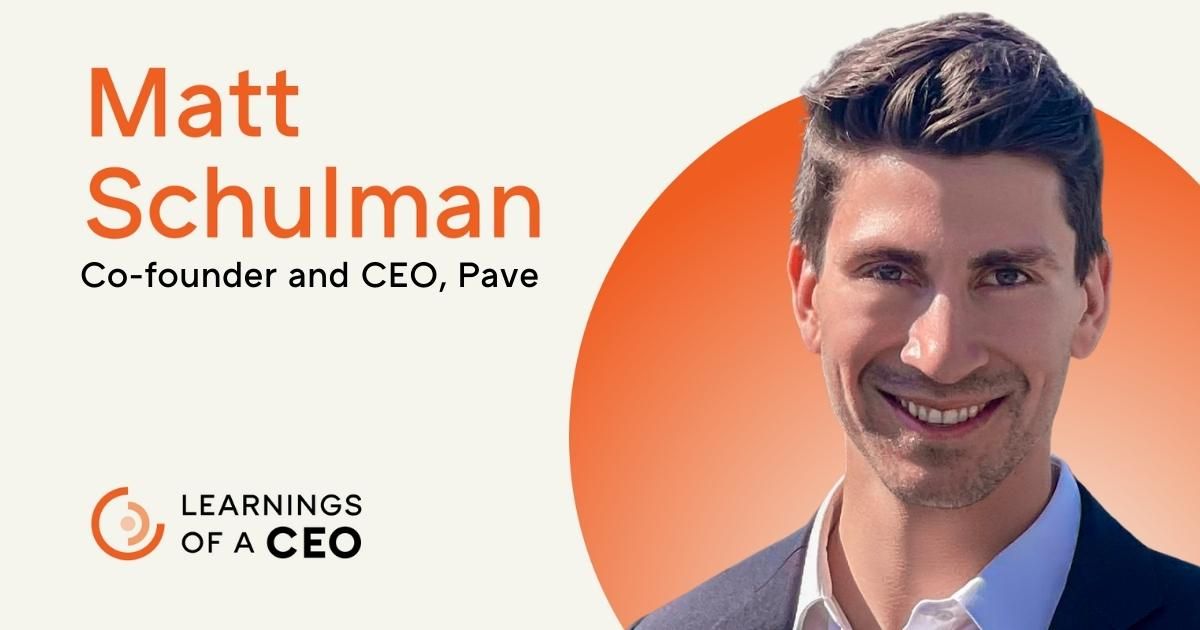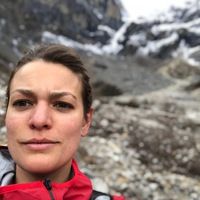Learnings of a CEO: Matt Schulman, Pave, on Hiring
by Lindsay Amos10/17/2022

Welcome to the third edition of Learnings of a CEO. You can read previous editions here.
Pave helps companies plan, communicate, and benchmark employee compensation. Today, the company has 160 employees, more than 3,500 customers, and is valued at $1.6B. Founder and CEO Matt Schulman has created one of the most comprehensive and thorough recruiting processes, which has made him one of the most successful recruiters in the YC community. We sat down with Matt to hear his insight on building a team in the early stages of his company and today as a CEO of a growth-stage company.
Many of the first Pave employees were hired as a contractor before converting to a full-time employee. Would you recommend this strategy to founders?
I strongly recommend the contract-to-hire setup in the early days of a startup, as it led me to have a 100% close rate with the candidates we wanted to convert to full-time. This strategy worked for two reasons:
1) By the end of the contract, the contractors had poured weeks of energy into the work – learning the code base and investing their time – and getting to know potential coworkers. This escalated their sense of commitment.
2) I was flexible on working hours – open to them working nights or weekends. This made it easier for the candidates who were busy with full-time employment to say yes to working with Pave and earn extra income on the side.
To convince people who were employed to work for Pave as a contractor on top of their current job, I framed the process as a mutual evaluation. This is an opportunity to evaluate the company and come to a mutual decision at the end of 2, 4, or 6 weeks together – no pressure. We paid them a fair market rate, and as mentioned, we were flexible on working hours. One contractor worked their day job until 5:00pm and then on Pave from 6:00pm-2:00am, for example. They were excited to be able to build something from the ground up and work closely with me at the earliest stage of the company – which is another strategy I used to encourage people to work with us.
Before Pave, I was an engineer at Facebook and regularly worked on side projects. These projects were my fun, guilty pleasures because when I built something from the ground up, I felt an emotional attachment to the work. Usually engineers at large companies feel part of a machine, but when they build something full-stack from the ground up, there’s a magical allure to that work. I gave those contractors ownership over the work and often jammed out with them – working side by side at all hours. (One note: I did not have the contractors touch customer PII.) Within weeks, we’d both know whether Pave would be a good fit, and if so, we were already committed to each other.
What were you looking for in early employees?
When starting to build out the team, I was given a tip that the first 10 hires would set the tone for the next 100. Because of this, I personally recruited 100% of the early Pave employees. I sourced people, took phone screens, went to dinner, coffee, and on walks with candidates, and spoke with them for hours on Zoom and Facetime. It was an all-encompassing process. But I found that early advice to be accurate: The first 10 employees are the most important aspect in the company’s life cycle – other than finding product-market fit – and recruiting has to be the founder’s priority.
When recruiting for the first ten employees, I wasn’t looking for experts in specific areas but generalists with rapid career growth, passion for our mission, and a hunger to work. Those early employees readily tackled whatever fire we were facing that day from engineering work and sales to back office and HR. I also had a deep level of trust with those first ten hires, as they were all in my network.
Today, I still look for mission alignment and hunger but there are times I need to hire a specialist. I identify the tightest set of criteria for the role and only talk to people who fit that criteria. This is very different from the early days when I was solely looking for generalists who could fill multiple roles.
How did you convince those early employees to join Pave?
I always found ways to continue our conversation even when I could sense the candidate wanted to turn down the offer. I would do this by scheduling future conversations – saying that I needed to share something new with them – and then I would get to work writing a Google Doc that showed how I planned to invest in their career. We still use this strategy at Pave today, but it has evolved and is now affectionately called the collaborative Google Doc.
The collaborative Google Doc is shared with the candidate and used throughout the entire interview process. The document outlines expectations for the role and frames the interview process in stages, communicating which stage the candidate is in at any given time to ensure we are working within their ideal timeline. We encourage the candidate to comment and add their thoughts to the document, including feedback for me and their thoughts on the interview process.
As we get further into the interview process, I get more specific about what I’m looking for in a candidate. And when we get even deeper, I write multiple pages on what I’ve learned about their career aspirations through our conversations and backchanneling, and how I’m going to support them.
When it comes to backchanneling for potential executive hires, I try to talk with at least 10 people and ask, “If I have the privilege to be this person's manager, I want to set them up for the utmost success. What are your specific recommendations about the best ways to set this person up for success and unleash their full potential?” This 360 review is shared with the candidate right before I deliver the compensation package. I outline what I learned about their strengths and weaknesses, and specific ways that I’ll push them and support them.
When I communicate compensation, I lay out all the facts, including cash amount, equity (shares and dollar amount), and the benefits package. In addition, we also share:
- The salary band for the role (and implicitly their position in it).
- The level that the employee will be in the organization, along with more information on our leveling framework and what each level means.
- The methodology for determining the compensation, like the market data we use (75th percentile for similar stage companies).
- Broader information on compensation philosophy, including how someone moves through the band, gets promoted, etc.
- Additional info on equity: current preferred price, current post money valuation, details on vesting, PTE window, 409A price, and more – essentially everything they need to determine the actual value of the grant.
We’re ultra transparent about compensation because compensation should not be a guessing game; people deserve to understand every aspect of their compensation package and how it was derived. I then offer to meet live to answer any questions or discuss feedback – or ask them to leave their comments in the Google Doc. Most candidates will ask questions in the document, as it can be more approachable.
For every open role at Pave, a Slack channel is created to drive urgency and ensure no detail goes missed. Tell me about this process.
As a seed-stage company, I was creating Slack channels for every role. Today, Slack channels are created for roles that I’m involved with – like hiring a head of finance or VP of engineering. The process still looks the same, however.
I create a Slack channel for that role and add relevant stakeholders. Every morning I ask for an update. What’s the movement? Have we sourced any more candidates? Have we talked with candidates X, Y, and Z? I do this to keep the process moving forward every day. I also post updates – sharing with the team when I spoke with a reference, for example. When we extend an offer, I use this Slack channel to encourage stakeholders to reach out to the candidate through text messages or Loom videos.
Loom videos are an interesting medium. If you’re a candidate and receive six Loom videos from different people at the company, it may feel bizarre and a bit overwhelming. But the videos show we are excited about the candidate and also gives insight into our energetic culture.
You also review email copy and do drip campaigns for candidate outreach. Tell me about this.
We have a pre-written email sequence that is sent from me or the hiring manager depending on the context, and then we use Gem to automate this. The response rates for these campaigns are much higher than if the emails were coming from a recruiter. Before the emails are sent out, I’ll spend 30 minutes personalizing 30 emails (one to two sentences at the onset of the email) that will be sent to target profiles. And then it’s important you do a drip. If you only send one email, most of the time the candidate won’t respond. I find sending a third email with a short message like, “Hey, any thoughts?” leads to the most responses.
How do you think about where your job ends and your team begins when it comes to recruiting?
Today, if I’m not the hiring manager, I delegate and come in only at the end of the process for a sell call. The process looks vastly different if I’m the hiring manager. I spend a lot of time reviewing resumes and identifying the top 25 profiles in the space. Every outreach to them is very personalized, and I have time to do this because I focus on quality over quantity of candidates. Quality over quantity was a big lesson for me, actually. At first, I would look at all inbound resumes and thousands of applicants. But I have come to realize that I have more success when I map out the market and find the top 25 candidates in the space. Then I'll find a way to get one of them in the door.
Describe the ideal candidate for senior-level positions when Pave was a smaller company.
As a company of 35 people, we didn’t need managers who delegated – which has merit at a later-stage company. We needed people who would personally take on the hard work. Often, first-time founders hire someone senior for optics reasons. Instead, you should look for someone earlier in their career who has grown at a crazy high slope – often referred to in the tech industry as a high-slope candidate versus a Y-intercept candidate. There is a time and place for both types of hires, but as a 35-person startup, almost always go for the slope, not the high Y-intercept. And in some cases, you may meet exceptional candidates with both high slope and high Y-intercept. This is the dream case!
Another mistake first-time founders can make is rushing hires by trying to squeeze them in before a term sheet. Don’t try to meet some arbitrary deadline or cliff date. If it takes six months or a year to hire an executive, that’s ok – wait for the right person.*
*This answer has been updated to clarify the founder’s intention behind the statement.
Companies Mentioned
Other Posts
What startup hiring looks like in 2021 — and during a pandemic
January 17, 2022 by Ryan Choi
Author

Lindsay Amos
Lindsay Amos is the Senior Director of Communications at Y Combinator. In 2010, she was one of the first 30 employees at Square and the company’s first comms hire.
